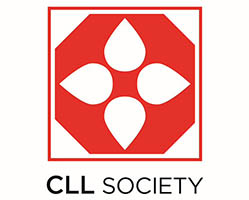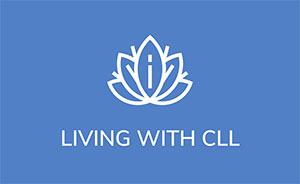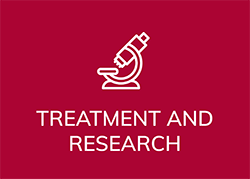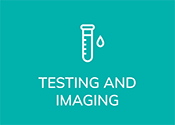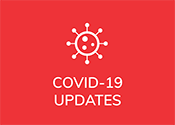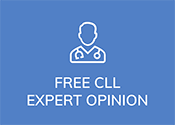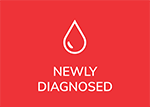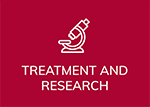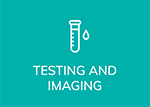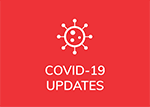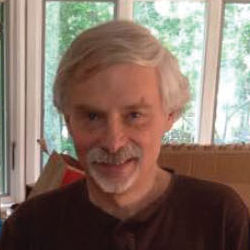
By Jay M. Blatt – Patient
I am just shy of 65 years old and have probably had CLL since 2012. My platelets had been spiraling down since around 2008. I was not officially diagnosed until January 2016, when I had horrible bronchitis as well as repeated cold sores, sinus and ear infections that simply would not relent. I believe that a modified macrobiotic health regimen that includes eating very wholesome foods, supplementing and exercise has given me a new lease on my CLL life! I don’t feel I can cure CLL, but I do believe that my integrative approach, which uses the best protocols both Western and Holistic medicine have to offer, gives CLLers many special health options and benefits. I want to share what I have done so as to encourage other CLL patients to not look at W&W as a time to watch and wilt, but instead to consider doing whatever you can to watch and win!
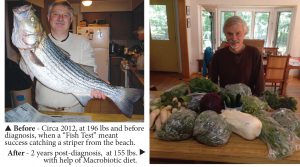 I am still treatment naive. For whatever the reasons, my trisomy 12, unmutated CLL has been behaving indolently. My platelets have stabilized and improved over the last 33 months. My ALC in January 2016 was 10.4 and in July 2018 was 15.1. My IgG is way up there at almost 1400. All traces of diverticulosis and acid reflux disease that I was told I had back in 2016 have miraculously disappeared. Some of my cholesterol values improved by close to 100%. I feel and look 20 years younger. I don’t get infections and have had only one cold in the 3 years since I began my health regimen. I want to urge my fellow CLLers to, throughout their disease process, do whatever is within their power to live a healthier CLL lifestyle.
I am still treatment naive. For whatever the reasons, my trisomy 12, unmutated CLL has been behaving indolently. My platelets have stabilized and improved over the last 33 months. My ALC in January 2016 was 10.4 and in July 2018 was 15.1. My IgG is way up there at almost 1400. All traces of diverticulosis and acid reflux disease that I was told I had back in 2016 have miraculously disappeared. Some of my cholesterol values improved by close to 100%. I feel and look 20 years younger. I don’t get infections and have had only one cold in the 3 years since I began my health regimen. I want to urge my fellow CLLers to, throughout their disease process, do whatever is within their power to live a healthier CLL lifestyle.
I practice a modified a macrobiotic diet / lifestyle which I have customized and continue to fine-tune to suit my particular situation. The basic macrobiotic diet includes a balance of whole grains (complex carbohydrates) such as brown rice, millet, buckwheat, whole oats, faro, barley etc.; a full spectrum of round, sweet, root and leafy vegetables; beans and soy products; nuts and seeds, fermented foods (natural probiotics) such as miso paste and sauerkraut; sea vegetables, fruit and some white meat fish. Foods should be organic when available and produce should be locally sourced or at least native to the temperate zone in which you live. I have included a small sampling of some of my favorite macrobiotic foods at the bottom of this article.
I incorporate gentle lymph massage and more vigorous skin rubs as part of my regimen. I practice allergen avoidance, keep indoor plants around to detoxify the air, and choose the most environmentally-safe household chemicals. Exercise figures prominently to move lymph, circulate blood and oxygenate cells and tissues. I run or walk 2-3 miles at least five times a week. Martial arts and yoga exercises are incorporated to stretch and strengthen muscles. I value both medical and holistic science since both offer unique benefits to CLLers and are complementary to one another. If what I do does not seem verifiable enough to satisfy your scientific curiosity, I apologize, but I’ll agree to disagree. I just want to report how macrobiotics might help other CLL patients, based on what I have seen it do for me and others. I understand that it may not be everyone’s cup of green tea.
Some of the health-oriented protocols that I advocate are not strictly macrobiotic. I supplement with vitamins D, B-12, mega B, a multi-vitamin, C and lysine. (Supplementing is controversial in some macrobiotic circles.) I also use matcha green, astragalus, turmeric and milk thistle teas, which are not all macrobiotic. Just eating macrobiotic foods does not necessarily mean that we are practicing a macrobiotic lifestyle. Macrobiotics is a lot more than nutrition—it’s a mindful and spiritual experience too. A basic tenet in macrobiotic thinking is “WHEN WE HELP OTHERS, we help ourselves even more!” I try to live my life in a way that lifts others up. It really does make me feel happy! Frankly, I didn’t think much about that, until CLL came knocking.
Macrobiotics are not a one-size-fits-all proposition. I’m a 64-year-old patient with what is generally considered a moderately aggressive form of trisomy 12, unmutated, zap-70 CLL. I have no fatigue, no infections and an IgG antibody level of close to 1400. I use integrative medicine to live a better, longer and healthier CLL life! I see a brilliant CLL medical specialist, who is well versed in the latest western medical and diagnostic protocols. I hold alternative healers to the same high standards that I hold medical doctors. Before trying macrobiotics, I contacted four cancer patients to determine if macrobiotics had been effective in their battles against cancer. Hope soared when a neighbor of mine, given less than a year to live with prostate cancer by medical experts, credited Macrobiotics for making him 14 years cancer free! I had lengthy communications with two blood disease patients, and both felt that macrobiotics was the reason they were still alive decades after diagnosis. I spent a few hours with a medically trained nurse (now a macrobiotic counselor) who claimed that macrobiotics had been the essential regimen that cured her breast cancer. I also emailed with three CLL patients who claimed to be lessening the impact of their disease by incorporating macrobiotics.
For the last three years, I’ve sought advice from some brilliant macrobiotic healers. I’ve read many articles and virtually every book available on the topic. During this same time, I’ve seen my general health steadily improve. CLL symptoms have diminished dramatically due to using macrobiotic principles. Macrobiotic healing may not be right for everyone. Just like medical intervention does not always yield perfect results, neither do macrobiotics. My contention though, is that for a large subset of CLL patients macrobiotics can significantly help them feel stronger, less fatigued and dramatically reduce symptoms. For me using this particular alternative mode has truly impacted my life in a positive way, so much so that I plan to become a macrobiotic counselor, completing my curriculum by January 2020. Time will tell if it slows disease progression or keeps me in watch and wait indefinitely.
What do macrobiotics mean to me as a CLL patient? They literally mean “big life”, as in taking whatever steps are necessary to maximize health! You’ll find as many definitions of macrobiotics as there are macrobiotic healers. In my case the phrases “you are what you eat” and “let food be thy medicine and medicine be thy food” best describe macrobiotics. It means returning balance to a life that has been turned topsy turvy due to the uncertainties of CLL. Modern day macrobiotics incorporates ancient Asian healing techniques of balancing yin and yang. If our body is out of balance, can we possibly take steps to bring us back to balance? If we are 50 pounds overweight, might we then eat a more wholesome diet, add exercise, and then lose the extra pounds so that we feel more energetic, and our body is less physically stressed? The extra weight would be expansive (yin) and getting back to a smaller size, would be contractive or (yang). I’ll confess that while I relate to the ancient Chinese medical/spiritual aspects of macrobiotics. I‘m mostly interested in the nutrients in macrobiotic foods, which I believe contain substances that impact blood values and, in some instances, discourage cancer.
Prior to my official diagnosis in January 2016, my platelets had been inching downward for many years. A medical doctor and acquaintance of mine had read how the macrobiotic diet had helped patients restore platelets. One of his patients tried macrobiotics and had good results. At diagnosis, my platelets were at 119. I researched and discovered that the Platelet Disorder Support Association, which receives advice from medical doctors and alternative healers, recommends a macrobiotic diet as being the best non-medical regimen to increase platelets. The more I looked into it, I discovered that some cancer patients had brilliant success with relieving cancer symptoms, and some gave macrobiotics full credit for their recovery! Livestrong.com offers a list of foods to increase blood platelets.
For my diet, I include as much local, organically grown food as possible. The theory is that our body adapts more easily to foods found naturally in our immediate environment. I do not eat meat, poultry, dairy, sugar, or most nightshade vegetables, mostly because I find these foods are too inflammatory and I have enough bumps, lumps and swelling to last me a lifetime! I avoid alcohol, white flour foods and processed junk foods—because they just make me feel lousy. I dramatically limit the intake of wheat and gluten to lessen allergic reactions. I eat 25% whole grains, 30% root, greens and sea vegetables, 15% fish, 5% soups, 10% beans, soy products like tofu and tempeh, and 15% salads, nuts, seeds and fruit. Macrobiotics advocates suggest using the healthiest ways to prepare food to maximize intake of nutrients. We generally chew food at least 30 times per bite to liquify foods and affect the best digestion of nutrients. To some extent, the way that we combine foods affect our ability to metabolize nutrients. Good digestion and elimination certainly play a role in our overall health. Even eating at the table in a relaxed state of mind, showing appreciation for having access to good food and not being distracted by digital stuff while sitting down to eat (TV, smartphones, etc.) makes for better metabolism. We avoid eating three hours before we retire for sleep. This gives our body a chance to wind down and to better digest nutrients while we sleep and heal.
In CLL terms, I lean heavily towards eating foods that contain vitamins B-9 (folate), B-12, B-17, A, K, D, E and C, to create more functional platelets, hemoglobin, red blood cells, white blood cells and to try to slow down my cancer. I also select foods that contain iodine, iron, selenium, genistein, phytonutrients and antioxidants, mostly to take advantage of their anti-cancer benefits. I have modified a traditional macrobiotic diet to lessen inflammation, boost immunity, heal existing comorbidities, slow CLL progression to whatever extent possible and improve health overall.
To understand how macrobiotics helped me, it helps to understand my health profile. I was born with iron anemia which was corrected through nutrition. My parents were two-pack-a-day smokers. Mom passed away at age 70 of lung cancer, dad succumbed to diabetes and a heart condition at age 80, and my sister died at age 60 after a 35 yearlong battle with multiple sclerosis. Two of my grandparents had cancer and died very young, and two lived into their nineties. I was a chubby child and basically ate the standard American pyramid diet. Dairy, meat, poultry, fish, frozen and canned veggies. Sugary processed foods that included cereals, white bread, and lunch meats were staples. Dessert after every major meal was commonplace. If it had nitrates, we ate it! As a young boy I was allergic to just about everything including nuts, pollen, wheat, dairy, cats, and even dogs made me sneeze. I suffered from earaches, lots of cavities, sore throats, postnasal drip, clogged sinuses, colds, and cold sores. In my early teens I developed a benign nasal polyp that had to be removed. By age 17, I had mononucleosis. Overall, I was healthy enough to excel in some sports, a saving grace that managed to slim me down somewhat.
Although I endeavored to improve my diet as an adult, I continued to enjoy dairy, meat, sweets and other less than healthful foods until about three years ago when CLL was diagnosed. My liver counts were always just little off as a teenager. From age 20-45, I seldom visited a doctor, but I had mysterious bouts of higher-than-normal white blood cell counts periodically, chalked up to being caused by allergies, illness or infections. In my early 50’s my cholesterol levels were high LDL, low HDL, high triglycerides, and higher than normal cholesterol. By age 55 my platelets were gradually spiraling down. By 2012, my platelets were at 141. I had mysterious pains in the groin area, constantly recurring cold sores, sinus problems, and ear infections. By 2014, my platelets were at 122. I felt somewhat fatigued, and some white blood cell levels were not normal. That’s when one doctor asked if I bruised easily or ever had night sweats? In October 2015 after a night of surfcasting, I returned home to find a six-inch blood clot on the inside of my thigh, that’s when the sirens started sounding. My official CLL diagnosis was in January 2016 with my platelets at 119. I felt anemic and had bronchitis for two consecutive winters. I was so breathless that it was difficult for me to speak without coughing in between sentences.
Soon a local oncologist/hematologist did some genetic testing and found that I was a trisomy 12, unmutated TP53 CLLer, with a zap-70 marker. A pet scan showed diverticulosis, as well as swollen lymph nodes and spleen. After being checked by an ENT due to swollen neck nodes and horrible heartburn, I was told I had a swollen esophagus and acid reflux disease. Welcome to the never dull world of CLL, or as I like to call it “the realm of never-ending boo-boos and the land of a 1,000 cuts.” By February 2016, I was on a strict macrobiotic diet.
Changes in my CLL and general health profile that I attribute largely to a macrobiotic lifestyle.
I believe if you can get rid of comorbidities, infections, inflammation, etc., you are bound to have less stress on your body’s immune system. Then your body has more energy and more soldiers to do battle with CLL. Make your body as inhospitable to the disease as you can and who knows?
that being said, I have experienced high energy and low weight due to macrobiotics. I initially dropped nearly 50 LBS and went from a high of 192 lbs. to a low of 138 lbs., eventually leveling off at my college fighting weight of 155 lbs. The weight stays off effortlessly and I eat like a horse (literally because of all the whole grain, and figuratively sometimes). With the drop in weight, I experienced a major surge of energy—my CLL fatigue disappeared! I now sleep between 5-6 hours nightly. I am able to run a small publishing business, jog or walk three miles almost daily, and also make time to go fishing and have fun with boundless energy on most days.
My ALT liver enzyme count went from 92 to 20, which is just spectacular. My blood pressure is that of a seasoned athlete. My cholesterol went from a lifetime high of 220 to a low of 110, with other cholesterol values almost halving and an excellent reduction in coronary risk.
It took 30 months, but my diverticulosis and acid reflux diseases completely disappeared! No constipation, no loose stools, no stomach pains, incredible digestion, and three or more healthy bowel movements every day. Most importantly- my platelets which had been gradually decreasing since 2008 and had reached a low of 113 and have remained for the last two years at 120-125. My red blood cells according to one doctor have maintained the shape of what healthy new blood cells appear like under microscopic scrutiny, which may indicate a reasonably functioning bone marrow.
My ALC was 10.4 at official diagnosis in January 2016. By January 2018 it was still at 10.78 and in July 2018, at 15.1. I’ll take it! Two of my doctors believe I have probably had CLL since at least 2012. This means that my CLL has been acting in a relatively indolent manner, even though I have a complex CLL unmutated karyotype. Neck nodes have remained reasonably small and not noticeable to the untrained human eye. No problems with nodes anywhere else as of yet, although a pet-scan 30 months ago showed my spleen and liver were somewhat enlarged.
Immunity wise, my allergies have improved 95%. I have no nasal congestion or earaches. No postnasal drip. I can sleep without constant tossing and turning due to clogged nasal passages. And no hay fever at all! At initial diagnosis, I had all kinds of chronic infections including cold sores almost every three months, but I haven’t had even one infection in the last eight months. I don’t get colds, sore throats, or bronchitis anymore.
My IgG value actually went up over the last 33 months from 1330 to a high of over 1400. Hopefully this means my immune system is liking what I’m doing. My vitamin D level at diagnosis was 21 and was 55 as recently as January 2018. My vitamin B-12 level (critical to producing functional red blood cells and platelets) is at a very high level of normal. My iron values are excellent as well. Macrobiotics seem to be agreeing with me. If it weren’t for having small nodes and very bouncy absolute neutrophil levels, I wouldn’t know I had CLL. I feel terrific. It’s as if I’ve turned back the aging clock. Even so, don’t be fooled by my bravado. I know at any given moment CLL can become a devious and treacherous foe. But for now, I am smacking it around a bit. And I like doing that! I feel like I have at least some control over some aspects of my disease.
Is there evidence that some medical doctors are gravitating towards integrative nutritional healing?
Some are 100% believers, while others still need convincing. My doctors are pleased as punch to see me doing so well. But nutrition and exercise are not really their thing. They love my results and encourage me to keep doing what I do, but I think in their heart of hearts, they are not fully convinced that what I do dramatically impacts CLL per se. That’s ok, my job is to just keep living well! My CLL doctors will know how to martial the drugs that might save my life if treatment becomes necessary. Their domain is medical healing, mine is holding CLL at bay and reducing a lion’s roar to a pussycat’s meow! Someday my CLL may come down on me like a ton of bricks, but I refuse to sit around and just WATCH and WILT – I want to watch and WIN!! My strategy is to go at least another ten years in watch and wait and hope that by that time there’s a complete cure, or at least drugs that are so efficacious and gentle that I won’t even know that CLL is around! I’d love to shock my doctors by being one of the few unmutated CLLers to ever go 30 years without requiring treatment!
Interestingly, there are some medical researchers who believe, as I do, that nutrition and some alternative healing modes influence a better CLL outcome. As recently as March 2018, CLL researchers in Spain conducted a study to compare three different dietary regimens. My take is that they concluded that statistically, CLL patients seemed to fare better on a predominantly plant-based Mediterranean type diet than they did on traditional western cuisine. The implication was that patients were more inclined to develop CLL from eating certain diets as opposed to enjoying others. Macrobiotics is similar to a Mediterranean diet, but in its strictest form does not allow for ANY meat, alcohol, poultry, nightshades, or dairy, which are perhaps important distinctions. Macrobiotics also looks at balancing food energies and food combining to achieve the best possible health, which are principles not found in most other disciplines.
You may have heard about the green tea CLL patient studies and how the catechin EGCG seemed to have helped some CLLers to dramatically lessen node size and lower ALC. Even some alternative healing naysayers still either drink green tea or supplement with EGCG to try and reduce lymph nodes and WBC counts. Some medical journal articles link turmeric to targeting CLL B-Cells, impacting cell apoptosis (death). Even the use of vitamin D was at one time in the realm of holistic healing, but today it is heartily recommended by medical doctors due to its immunity boosting effects. My community oncologist/hematologist recommended it and helped me to get my vitamin D value from 21 at diagnosis to 55 presently. Vitamin D may possibly slow CLL progression, and research is currently being evaluated to substantiate that. Doctors also regularly advise patients to increase their vitamin B-12 levels if certain anemias are suspected. Vitamin B-12 and folate are essential to build properly functioning platelets and red blood cells. So, don’t let anyone tell you that just because certain remedies initially may have had more usage in non-medical circles, that they don’t eventually become mainstream staples. Often, they do. It’s no coincidence that almost all CLL institutions now have “integrated healing departments” and subscribe to the notion that alternative healing modes can be very helpful to CLLers.
Dr. Bill Li, M.D., is a well-respected cancer researcher who has linked certain foods to having properties that prevent cancer cells from being able to grow blood vessels to take in nutrients, thus preventing them from flourishing and metastasizing. He feels that eating certain foods will encourage “anti-angiogenesis,” thus starving cancer cells to death by using nutrition. Many of the foods that Dr. Li encourages us to eat to starve cancer cells, happen to be the very foods that macrobiotic practitioners promote. So, there is much synergy these days between medical and holistic healers. Please view this 20 minute talk that Dr.Li did at a TED CONFERENCE, then ask yourself if there may be a connection between smart nutrition and CLL outcomes?
In the last 33 months, I’ve had two medical doctors who suffer from CLL themselves ask me how they can incorporate macrobiotics into their own lifestyle! I have been approached by a CLL patient who is a naturopathic physician, to collaborate on how she can best incorporate macrobiotic principles into her own healing. I’ve had lengthy discussions with over 50 CLL patients who expressed interest in macrobiotics as a way to relieve CLL symptoms or diminish the side effects of medical treatment. I always give people the best advice I can from a patient’s perspective and I encourage them to first discuss their questions with their medical doctors or make the time to visit a trained macrobiotic counselor to get the best guidance.
Allow me to close with these realizations: There are CLLers who use alternative healing as a means of slowing down disease progression and even a few who have used alternative healing specifically to try and bring themselves into remission. They may not be technically cured, but sometimes they do achieve good results. You may have heard of Glenn Sabin, the Harvard-Medicine-studied CLL patient who through an alternative mode that included good nutrition, supplementing and exercise protocols, is said to have achieved remission. David S. Rosenthal, M.D., a professor of Medicine at Harvard and a past president of the American Cancer Society said, “When I first met Glenn 10 years ago, he told me he was going to beat his chronic lymphocytic leukemia. Since then, I have followed his activity and daily regimen, and indeed, he has been extremely successful. Is he an outlier or is his regimen worth studying on a larger scale?” How could any CLLer not be encouraged about the potential benefits that complementary healing might offer us, when you have a former president of the American Cancer Society going on record about a fellow CLLer’s documented results? How can we not at least be somewhat curious about an integrative medicine approach?
Dr. Neal D Barnard, MD, President of the Physicians Committee for Responsible Medicine said this about macrobiotics, “To a physician, macrobiotics is impressive. I have seen many patients who faced daunting medical problems for which mainstream approaches were simply ineffective, and who use basic macrobiotic principles to regain their health and vitality.” I could relate many documented events where medical doctors who have witnessed their own patients recover from catastrophic illnesses (this is commonplace in macrobiotic healing circles) after they had been deemed no longer medically treatable!
So, in a nutshell, healing from CLL in my view, can be achieved more easily by combining the best that both Western medical and holistic healing have to offer. Macro is a “medicinal diet”, offering incredible advantages over many other diets, as well as much documentation from actual cancer patients who claim to have reduced the impact of their illnesses with it. Whether we are in watch and wait or in treatment, regimens like macrobiotics are for most of us, something that we can carefully attempt. We are not powerless! The vast majority of us do not have to sit around watching and waiting, we can make moves towards maximizing our general health. Ultimately macrobiotics or a modified macrobiotic approach may be just what the doctor ordered to help us feel stronger, empowered, hopeful and fit enough to withstand the rigors of medical treatment, should it come to that.
– – – –
Jay’s Macrobiotic Food List for CLLers
The following list of 20 foods are just a small sampling of foods that I eat regularly. There are hundreds of delicious macrobiotic dishes to enjoy. I have done my personal best to explain the nutritional values in these foods.
1) ADUKI BEANS: A one cup serving contains 294 calories, 17 grams of protein, and 17 grams of fiber. Its fiber content may lower your risk for heart disease, constipation and diverticulitis. Their high folate value may help us to form red blood cells and platelets. Packed with iron to prevent anemia, one cup offers these values: Folate 70%, thiamine 18%, B-6 11%, phosphorus 39%, potassium 35%, magnesium 30%, zinc 27% and iron 26%.
2) BROCCOLI: A strong anti-inflammatory. A study of people who smoked 10 cigarettes a day and consumed steamed broccoli (1.66 cups worth) for a ten-day period found that their C-reactive protein (measure of inflammation) dropped, and their level of folate increased! (In CLL, it’s great to increase platelets and red blood cells). Folate has synergy with B-12 and that helps us with many blood values and discourages anemia. Broccoli, due to its phase 2 detoxification ability (glycosylates), activates this detoxification process in our cells which prepares toxic substances for elimination in our body. Broccoli’s glycosylates convert to ISOTHIOCYONATES -SULFORAPHANE, an ITC that protects the health of the stomach lining by preventing bacterial overgrowth of Helicobacter Pylori bacteria, which can sometimes lower platelets. An excellent source of Vitamins A and K, which helps us to utilize vitamin D. Eat steamed broccoli as often as you can. One cup offers these nutritional values: Vitamin-K 245%, vitamin C 135%, folate 42%, vitamin A 13%, iron 6%, and selenium 5%.
3) BROWN RICE: One cup contains daily nutritional values of manganese 88%, selenium 35%, phosphorus 23%, magnesium 21%, copper 21%, and Vitamin B3 19%. So, the anti-oxide enzyme called superoxide dismutase (WHICH IS INFLUENCED BY MANGANESE found in brown rice) is found in the body’s mitochondria and influences cell energy. It provides protection against damage from free radicals produced during energy production. Manganese produces energy from proteins and carbohydrates. Brown rice is a great source of fiber, too! This is a complex carbohydrate that provides energy over a long period of time.
4) BUCKWHEAT: Can be served as an alternative to rice or made as porridge. Though generally thought of as being a grain, in reality, it’s actually a fruit seed related to rhubarb, suitable for people who may have allergies to grain that contain glutens. It is great for blood sugar control, and absolutely delicious and nutritious when eaten as a noodle, too! Some feel that having high manganese content causes it to have anti-diabetic properties. Buckwheat is considered very heart healthy and packed with antioxidants and is also a wonderful source of fiber. Researchers are currently gathering evidence to substantiate its role in possibly fending off breast cancer. The B vitamins, phosphorus, manganese, and zinc, all help with healthy circulation and blood vessel function. Buckwheat has a delicious nutty flavor. One cup offers these nutritional values: Manganese 34%, copper 28%, magnesium 21%, fiber 18%, and phosphorus 17%.
5) BURDOCK ROOT: Burdock root is a major anti-inflammatory root with thousands of years history in Ayurvedic and Chinese medicine. These disciplines consider it to be a blood purifier. It has an OXYGEN RADICAL ABSORBANCE CAPACITY (ORAC) that is 50% higher than blueberries. This root can prevent intestinal damage and has been found to decrease inflammatory cytokines in lab induced colitis, in animals. I eat burdock 3x a week. It’s delicious when cut into thin matchstick like strips, sautéed in sesame oil and shoyu, with mixed carrots and onions. One root (156 grams) offers these daily nutritional values: B-6 30%, fiber 6%, and protein 14%.
6) CABBAGE: May protect against type 2 diabetes and is a good source of fiber too. Rich in antioxidants and anti-inflammatory substances, it lessens chronic oxidative stress, a risk factor for cancer. One cup has these values: V-K 79%, V-C 69%, B6 20%, manganese 17%, potassium17%, folate 9%, copper 9%, magnesium 6%, and selenium 6%.
7) CARROTS: Great for heart, liver, and eye health, as well as cancer protection. One cup of carrots has POLYACETYLENES, which are anti-cancer protein protection properties that have been linked to leukemia and colorectal cancer prevention. Nutritional values include Vitamin A 113%, biotin 20%, vitamin K 18%, fiber 14% vitamin C 10%, manganese 9%, vitamin B3 8%, folate 6%, copper 6%
8) CHICKPEAS (GARBANZO BEANS): Provides lots of antioxidants. The mineral MANGANESE is a key antioxidant in the energy producing mitochondria found inside most cells. You get 85% of your manganese daily nutritional values in one cup of chickpeas. This legume helps to reduce the risk of heart disease as well as to regulate blood sugar and is a great digestive aid. One cup offers 50% of your daily fiber requirement. The garbanzo gives you a ton of folate and iron which are essential for building healthy red blood cells and platelets and to preventing anemia. One cup includes these nutrutional values: Molybdenum 273%, manganese 85%, folate 71%, copper 64%, fiber 50%, phosphorus 39%, protein 29%, iron 26%, and zinc 23%.
9) GREEN TEA: Green tea is alleged to have many valuable attributes for CLLers. Nearly a decade ago some major CLL institutions began to research the benefits of a specific kind of green tea with small trials completed on CLL patients. Those who had relatively moderate versions of CLL appeared to see lessening of both the absolute lymphocyte count (ALC) and their tumor burden. Some researchers believe that the CATECHIN in green tea known as EGCG (epigallocatechin-3-gallate) is a substance that directly affects CLL. I drink 2-3 cups daily of a strong MATCHA type green tea. While this is a fraction of the amount of EGCG that I might derive from taking a green tea supplement, (the amount of EGCG used in the CLL trials was probably close to 80% more). I feel that drinking the tea while not offering the same “chemo-like” effect that a stronger capsule form supplement might offer, may still be somewhat helpful in slowing down disease progression, without risking or stressing my liver. Green tea also is very helpful for encouraging better teeth and gum health. Another less heralded effect of green tea is the caffeine pick me up. One cup by mid-afternoon just perks me up dramatically. CLL tip – if you have low platelets, drink green tea 3-4 hours before or after meals, as it may cancel out the effects of other foods that you would be using to try and boost platelets. Also, green tea and turmeric are being touted as possibly lowering white blood cell counts. It’s best to use each one on separate days to get a synergistic effect. Green tea has lots of great vitamins and minerals in it, including vitamin C and folic acid. Green tea should be part of any CLLer’s health regimen while in W&W. But check with your doctor to make sure that it will not conflict with any medications that you might be taking.
10) KALE: The great vitamin K green veggie! Kale plays a major role in clotting and in protecting blood vessels and is probably the best all-around CLL veggie! Kale is the richest LUTEIN vegetable. This carotenoid is supportive to eye health and prevents damage from light or oxygen and is believed to be anti-glaucoma. Kale is great for heart health, lowering cholesterol, raising HDL and lowering LDL. Kale, due to its natural glycosylates, is a natural body detoxifier. It is an antioxidant, an anti-inflammatory, and contains anticancer nutrients called glycosylates. Just one cup contains 1180% of your daily requirement of vitamin K. If you are a CLLer and you don’t know what Vitamin K does for you – LOOK IT UP!!!!!! It really impacts both your ability to make certain blood cells and to help you metabolize vitamin D. And if you don’t know why vitamin D is important, Google all the studies that tie vitamin D into influencing CLL disease progression. Kale lowers oxidative stress, and this may help prevent other secondary cancers. One cup provides these daily values: Vitamin K 1180%, vitamin A 98%, vitamin C 71%, manganese 27%, copper 22%, iron 7%, vitamin B6 11%, potassium 8%, magnesium 6%, folate 4% and phosphorus 5%.
11) LENTILS: A lentil is a legume and like many beans, very heart healthy. In the case of CLLers, lentils are thought by some healers to be very helpful in promoting quantity and quality of platelets. This bean gives us energy by slowly burning complex carbohydrates alongside its soluble fiber that can help stabilize blood sugars. Iron is a major component of hemoglobin. Just one cup of lentils gives us 37% of our daily iron requirement and can help to combat anemia. Hemoglobin transports oxygen from the lungs and all body cells and is also part of key enzyme systems for energy production and metabolism. Molybdenum activates antioxidants in blood, while protecting against cell damage. Molybdenum allows cells to produce energy and it helps the body create new cells. It is also implicated in playing a role in liver detoxification. Vitamin B-6 is required in the initial production of hemoglobin molecules. One cup of lentils offers these daily nutritional values: Molybdenum 330%, folate 90%, copper 56%, phosphorous 51%, manganese 49%, iron 37%, zinc23%, vitamin B6 21% and potassium 21%.
12) LOTUS ROOT: According to a study done in a Biotechnology and Biochemistry magazine published in 2012, this vegetable may actually shrink a swollen liver and lower the amount of fat in our liver. This is a delicious crispy vegetable that resembles coconut in taste. One root offers these daily nutritional values: Potassium 16%, phosphorus 10% (PHOSPHORUS is necessary for repairing cells and creating DNA), Vita min C 73%, and daily fiber 25%. It has a lot of iron to build red blood cells too. Eat lotus root to relieve nasal and lung congestion and to reduce all bronchial related problems.
13) MILLET: Good for heart protection and reduces asthma symptoms. One cup offers these daily nutritional values: Phosphorus 25%, manganese 24%, magnesium 19%, and copper 31%. Phosphorus helps create the energy currency of the body and is component of nucleic acids (the building blocks of the genetic code). Tastes pretty delicious too, similar to mashed potatoes.
14) MISO and MISO SOUP: Miso is excellent for cardiovascular health and is a natural probiotic packed with antioxidants. It’s a paste-like substance derived from fermented soy and other ingredients. Rich in vitamins B, E, and K, as well as folic acid, zinc, and copper. The fermentation process makes miso rich in enzymes and enhances the beneficial bacteria in food. These bacteria are known as probiotics, which help us with digesting, absorbing, and assimilating nutrients. By eating fermented foods, we increase the health of our micro-biome and digestive system. I eat miso soup every day. An assortment of very healthy vegetables may be added to the broth including wakame, onions, daikon radish and kale, to achieve an exceptionally nutritious, anti-cancer and immunity enhancing meal. Some people add tofu, udon, or soba noodles.
15) PARSLEY: The volatiles in this green food are currently being studied for the possibility of having chemo-protective-like properties. Half of a cup provides these nutritional values: Vitamin K 554%, vitamin A 14%, folate 12%, iron 10%, copper 6%, and zinc 3%. It has been shown to inhibit tumors of the lung in animal studies.
16) SHIITAKE MUSHROOMS: This type of mushrooms are anti-inflammatory and loaded with B-complex vitamins. Shiitake prevents unwanted blood vessel constriction, and due to the presence of BETA-GLUCAN in this mushroom, our immune system is enhanced. Half of a cup has these daily nutritional values: Copper 72%, pantothenic acid 52%, selenium 33%, vitamin B-2 9%, vitamin B6 7%, vitamin B3 7%, vitamin D 5%, and folate 4%. It may help somewhat with increasing neutrophils if you combine shiitake mushrooms with organic brown rice. It has for me.
17) SPINACH: Full of chlorophyl, it has anti-cancer and anti-inflammatory flavonoids up the yin/yang! (This is not a macrobiotic food, but there is some flexibility with adding non-macrobiotic foods when they have something else that is very healthy to offer. Just don’t overdo this one). One cup of spinach contains the following daily nutritional values: Vit-K 987%, vitamin A 103%, manganese 54%, folate 66%, vitamin C 24%, potassium 24%, zinc12%, and selenium 5%.
18) TOFU: This one can be controversial mostly because most people buy the commercial, over-processed stuff that is not fermented long enough. That said, I eat only the best, most naturally manufactured soy products! I eat tofu four times per week. You must try a brand called Bridge TOFU. Hands down, absolutely delicious. Sprinkle it on a salad and it will taste like cheese. Cook it on the stove and it’s out of this world! Tofu is actually good for your heart and lowers LDL cholesterol. Some believe that genistein, which is a soy isoflavone, increases the activity of a tumor suppressor protein called P53. More active P53 triggers programmed cell death in cancer cells! Others theorize that genistein blocks the activity of protein kinases which slows tumor growth in breast and prostate cancers. Tofu is made from fermented soy. Although it is controversial, it is viewed by both medical and integrative providers as having many more benefits than negatives when not overused and when the ingredients are totally NATURAL and not mixed with fillers. A four-ounce serving has these daily nutritional values: Calcium 77%, manganese 67%, copper 48%, phosphorus 31%, omega 3 fatty acids 20%, iron 17%, magnesium 16%, and zinc 16%.
19) WATERCRESS: I attended a CLL forum a while ago, and one of the guest speakers said this was being studied for its anti-leukemia / anti-cancer features. Some believe that watercress outperforms broccoli in thwarting cancer cells in lab tests. The theory is that watercress may help to turn off the signals that cancer cells send out to the body for more blood and oxygen. One cup offers these daily nutritional values: Vitamin A 22%, vitamin C 24%, and vitamin K 106%.
20) WINTER SQUASH: A superb source of antioxidants, especially vitamin A. Winter squash contains lots of B vitamins. It is an amazing anti-inflammatory round vegetable that is sweet and delicious. Just one cup offers these daily nutritional values: Vitamin C 26%, vitamin A 59%, fiber 23%, manganese 19%, vitamin B6 19%, copper 19%, potassium14%, vitamin B-2 11%, folate 10%, magnesium 7% and vitamin B-3 6%. It has plenty of folate too for proper red blood cell and platelet development. For a real treat, you can save the seeds and toast them. Add a little shoyu sauce for a mouthwatering, highly nutritious, snack!
_ _ _ _ _ _
Please do your own research about the nutrients and substances, as I am sure that there can be conflicting or varying opinions as to what the nutrients in these foods do! If this diet intrigues you, please see an experienced macrobiotic counselor who will diagnose and advise you according to macrobiotic healing principles and your specific health problems. You can generally find local macrobiotic practitioners with a simple Google search. Here are a few recommended books about macrobiotics:
- Modern Day Macrobiotics by Simon Brown
- Complete Macrobiotic Diet by Denny Waxman
- Recalled By Life by Anthony J Sattilaro
Links included in the article above about foods and how they affect human physiology. Always consult your medical physician before you radically change your diet, just to play it safe. Slow and steady is the only way to approach macrobiotics. You can experiment by adding foods to your diet but bear in mind macrobiotics also requires the avoidance of certain foods, too!
(1) https://www.youtube.com/user/PersonalCureTV
(2) https://www.livestrong.com/article/127280-foods-increase-blood-platelets/
(3) http://www.cancernetwork.com/chronic-lymphocytic-leukemia/western-diet-linked-cll
(4) https://clinicaltrials.gov/ct2/show/NCT00262743
(5) https://www.ncbi.nlm.nih.gov/pmc/articles/PMC5386343/
(6) https://www.ted.com/talks/william_li
(7) https://glennsabin.com/wp-content/uploads/2016/01/Glenn_Sabin_Cureus_case_report.pdf
For the past 22 years, Jay Blatt has lived with his wife, Vicki, in East Hampton NY, where they run a trade publishing company and ad agency. Jay is student of the martial arts, enjoys writing, reading and fishing for striped bass. By 2020, Jay hopes to have completed his formal studies in macrobiotic healing and to open a small health advocacy business. His lofty goal, besides helping the general public to get healthier, is to develop the ideal diet to help CLLers reduce symptoms and remain as healthy as they can throughout their CLL journey.
Originally published in The CLL Tribune Q3 2018.
